Our verdict
- Top pick in best running shoes for heavy men (2024)
Pros
- Reliable, stable ride
- Gobbles up miles
- Comfy and secure heel hold
- Generously padded
- Breathable and roomy toebox
- Great traction even when wet
- Can handle light trails
- Works well as a walking shoe
- Just as comfy in the winter
- Durable and sustainably produced upper
Cons
- 12.6 mm drop may not suit all runners
- A little wide for narrow feet
- Somewhat heavy
- Lacks bounce
Audience verdict
Comparison
The most similar running shoes compared
+ + Add a shoe | |||||
|---|---|---|---|---|---|
| Audience score | 86 Good! | 88 Great! | 86 Good! | 85 Good! | |
| Price | $140 | $170 | $140 | $140 | |
| Pace | Daily running | Daily running | Daily running | Daily running | |
| Shock absorption | Moderate | - | Moderate | - | |
| Energy return | Low | - | Low | - | |
| Traction | Moderate | - | High | - | |
| Arch support | Stability | Stability | Stability | Stability | |
| Weight lab Weight brand | 10.7 oz / 302g 10.8 oz / 305g | 11.6 oz / 329g 11.8 oz / 334g | 10.1 oz / 286g 4.9 oz / 140g | 12.5 oz / 353g 12.2 oz / 346g | |
| Drop lab Drop brand | 12.6 mm 12.0 mm | 7.2 mm 8.0 mm | 12.9 mm 12.0 mm | 12.1 mm 12.0 mm | |
| Strike pattern | Heel | HeelMid/forefoot | Heel | Heel | |
| Size | True to size | Slightly small | True to size | Slightly small | |
| Midsole softness | Balanced | Balanced | Balanced | Firm | |
| Difference in midsole softness in cold | Small | Normal | Small | Small | |
| Toebox durability | Good | Decent | Decent | Decent | |
| Heel padding durability | Good | Bad | Good | Good | |
| Outsole durability | Good | Good | Good | Good | |
| Breathability | Moderate | Moderate | Moderate | Moderate | |
| Width / fit | Medium | Medium | Wide | Medium | |
| Toebox width | Medium | Wide | Medium | Medium | |
| Stiffness | Moderate | Stiff | Moderate | Stiff | |
| Torsional rigidity | Stiff | Stiff | Moderate | Stiff | |
| Heel counter stiffness | Stiff | Stiff | Stiff | Moderate | |
| Heel lab Heel brand | 37.7 mm 37.5 mm | 39.1 mm 41.0 mm | 38.0 mm 38.0 mm | 36.5 mm 36.0 mm | |
| Forefoot lab Forefoot brand | 25.1 mm 25.5 mm | 31.9 mm 33.0 mm | 25.1 mm 26.0 mm | 24.4 mm 24.0 mm | |
| Widths available | NormalWide | NormalWide | NormalWide | NarrowNormalWideX-Wide | |
| Orthotic friendly | ✓ | ✓ | ✓ | ✓ | |
| Season | All seasons | All seasons | All seasons | All seasons | |
| Removable insole | ✓ | ✓ | ✓ | ✓ | |
| Ranking | #399 Bottom 39% | #137 Top 37% | #179 Top 48% | #220 Bottom 41% | |
| Popularity | #381 Bottom 42% | #281 Bottom 25% | #210 Bottom 43% | #187 Top 50% |
Who should buy
We recommend the Mizuno Wave Inspire 20 as a great choice for:
- Overpronating runners in need of a comfy and stable daily trainer with a spacious toebox
- Heel-striking runners looking for a well-cushioned shoe that's protective and responsive enough for long-distance and marathon training.
- Those who prioritize reliable traction and want a shoe that can tackle some off-road activities
- Year-round runners in the market for a shoe that's breathable but performs consistently in the cold

Who should NOT buy
The Wave Inspire 20's 12.4 mm drop might prove to be a little too steep for runners with a forefoot striking stride. We recommend the Saucony Tempus (8.5 mm) or the Hoka Gaviota 5 (2.2 mm) as more suitable alternatives for their strike pattern.
While the Wave Inspire 20's toebox is accommodating enough to provide a comfy fit for those with normal to wide feet, it will likely prove a little too roomy for those with narrow feet. We recommend checking out the ASICS Gel Kayano 30 for a more snug and locked-in feeling at the forefoot.
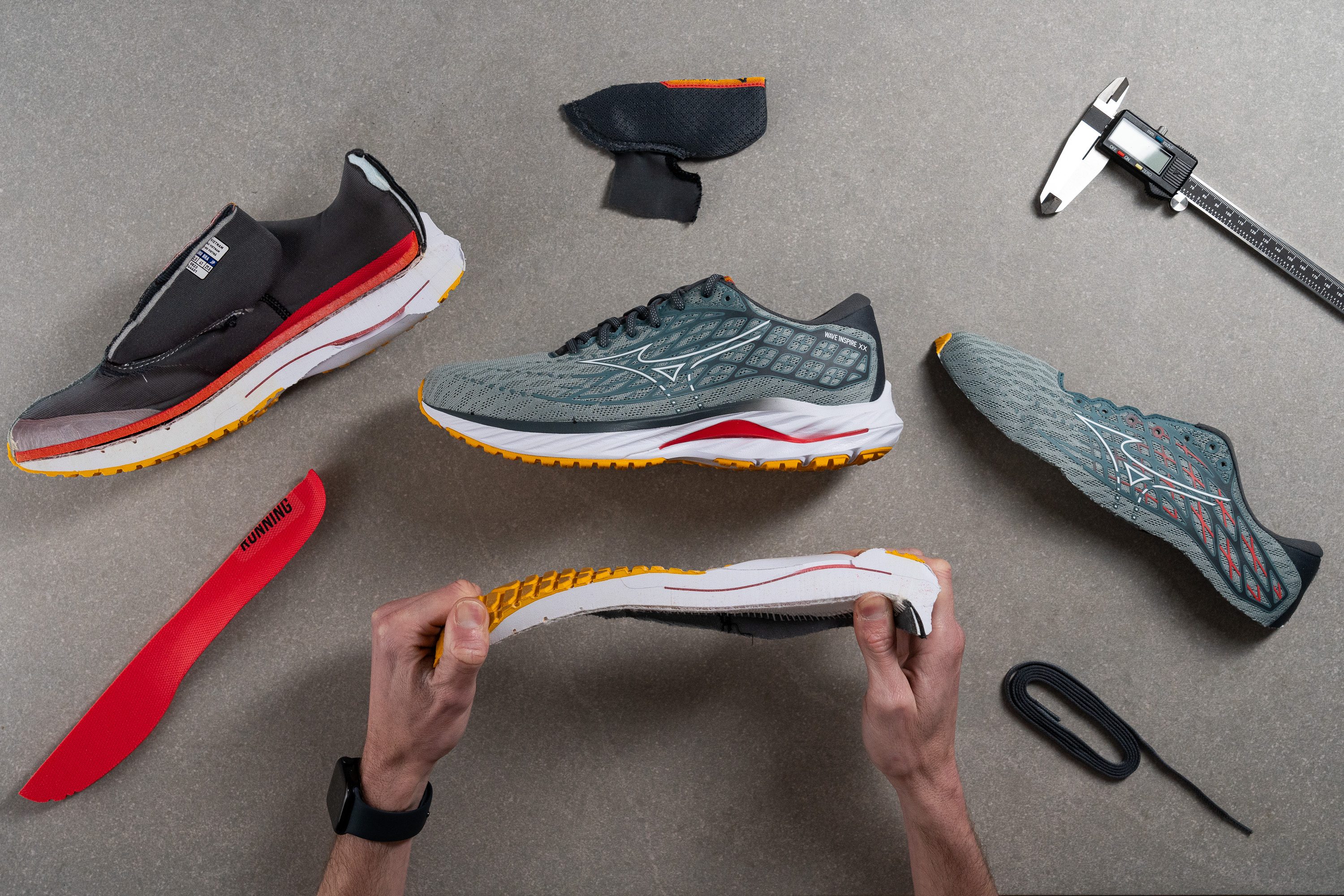
Stability shoes tend to be on the heavy side and the Wave Inspire 20 is no exception at 10.7 oz (302g) according to our scale. For runners who prefer a more lightweight ride, we recommend the Saucony Guide 16 (9.70 oz/275g) or the Hoka Arahi 6 (8.89 oz/252g).
Cushioning
Shock absorption
We tested the Wave Inspire 20 in the lab and found that it strikes a middle-ground balance with average shock absorption despite having a higher-than-average stack height in the heel.
It scored only 121 SA in the heel and 104 SA in the forefoot, numbers that solidify its role as a versatile, short-to-mid distance option rather than something you'd pick for a high-mileage, marathon-style effort.

| Wave Inspire 20 | 121 SA |
| Average | 129 SA |
Energy return
We never felt much energy coming back from the midsole, but we hoped it would at least hit 50%. Instead, it delivered a disappointing 44.2%, making this shoe a poor choice for all performance-focused runners.
| Wave Inspire 20 | 44.2% |
| Average | 58.5% |
Heel stack
Those with a rearfoot strike pattern will love the Wave Inspire 20's beefy heel stack which we measured with our caliper to be 37.7 mm thick. This is significantly higher than our current lab average and means that we have plenty of foam underfoot for well-protected heel landings while testing this shoe.
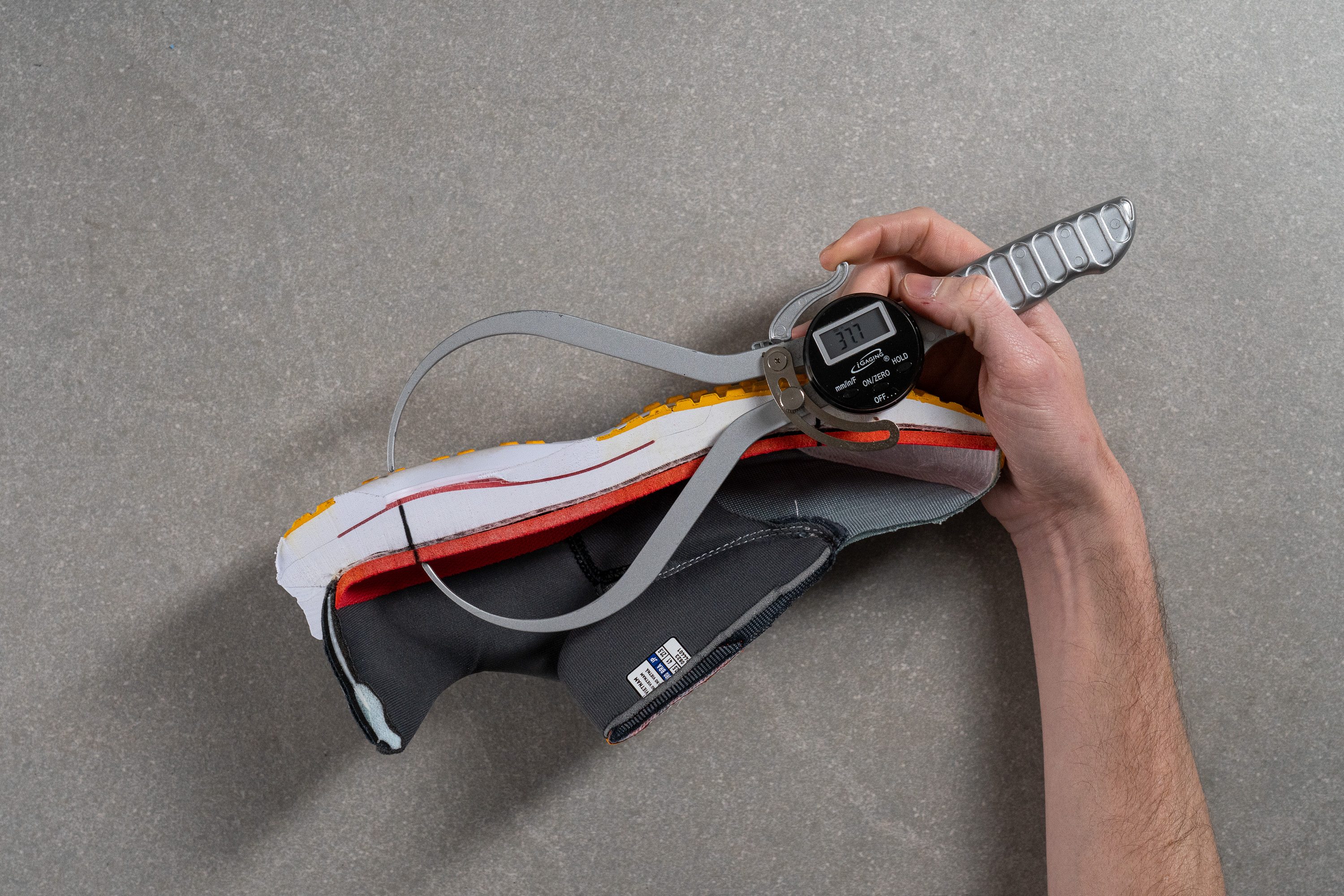
Apart from being beneficial for heel-strikers, this feature is excellent for long-distance running where fatigue can affect our running form and cause midfoot/forefoot strikers to revert to heel striking as the miles wear on.
| Wave Inspire 20 | 37.7 mm |
| Average | 34.8 mm |
Forefoot stack
The Wave Inspire 20's stack isn't as chunky at the forefoot, measuring 25.1 mm thick according to our caliper. This amount of foam underfoot effectively mutes out the harsh road below by allowing our feet to sink into and savor the midsole cushioning from landing to toe-off.
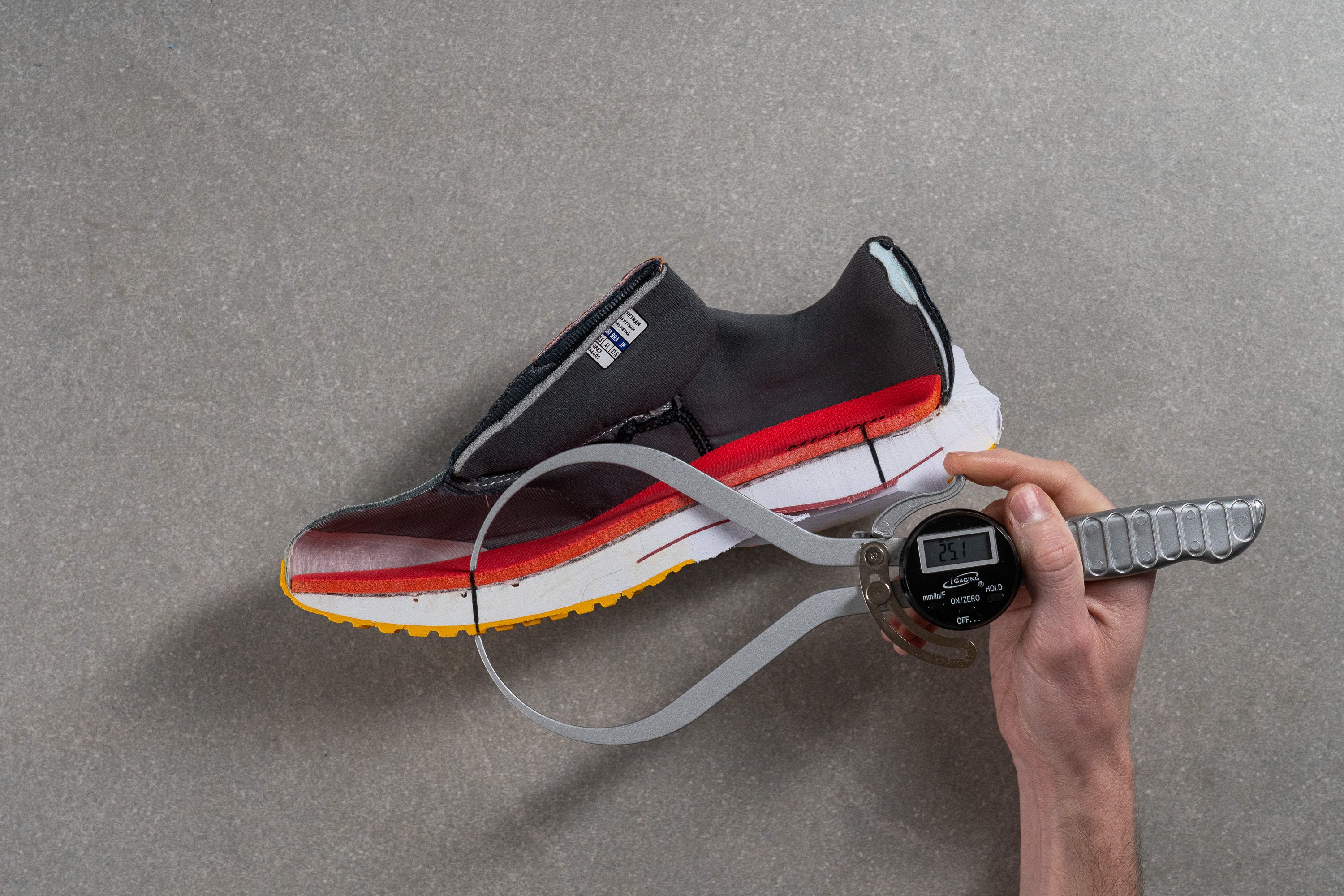
| Wave Inspire 20 | 25.1 mm |
| Average | 26.2 mm |
Drop
The difference in our stack measurements leaves the Wave Inspire 20 with a drop height of 12.6 mm, making the 12 mm offset stated by Mizuno quite accurate. While this might sound like a given, our findings in the lab so far have turned up quite a few disparities in manufacturer-stated heel drops as we explore in this article.
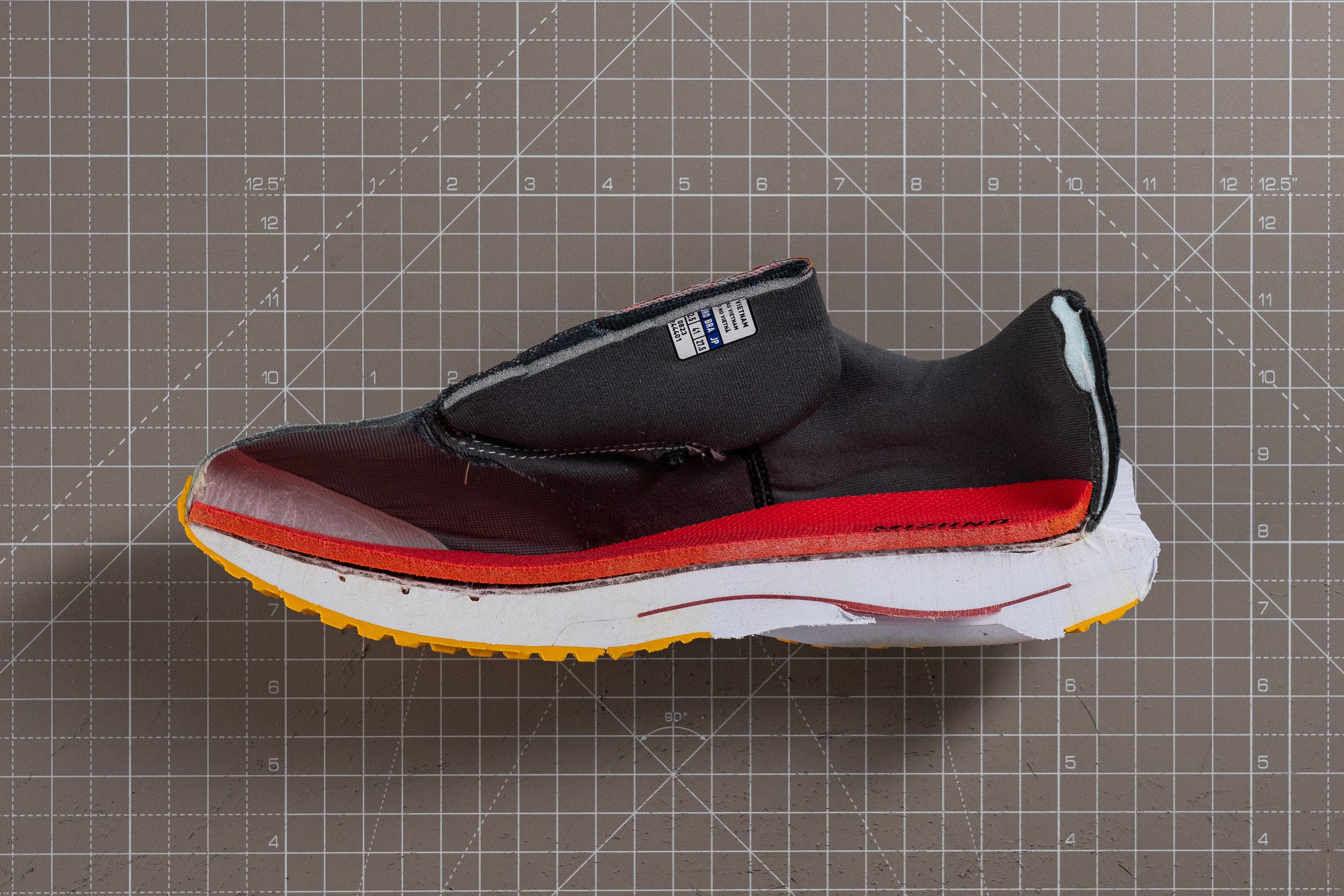
High-drop shoes like the Wave Rider 20 are generally more advantageous for those with a heel-striking stride or those with lower leg issues. That said, we found that the midsole's SmoothRide rocker geometry promotes smooth transitions that even midfoot and forefoot strikers can appreciate.
For runners who prefer shoes with less drastic offsets, we recommend looking into the Saucony Tempus (8.5 mm) or the Hoka Gaviota 5 (2.2 mm) instead.
| Wave Inspire 20 | 12.6 mm |
| Average | 8.6 mm |
Midsole softness
We pressed our durometer against the Wave Inspire 20's Enerzy Foam midsole and got a reading of 22 HA. This is about as soft as our current average for road shoes.

This level of softness is exaggerated by the shoe's healthy stack, allowing us to really savor the shoe's cushioning as it dampens the impacts of our landings. At the same time, the Wave plate embedded in the midsole prevents us from sinking into the midsole too much which contributes to the shoe's comfy yet stable ride.
The Enerzy Foam also has a pleasant and responsive rebound with a slight springiness to it that felt great whether we were out for an easy recovery run or testing our gas tank with a marathon training session.
| Wave Inspire 20 | 22.0 HA |
| Average | 20.4 HA |
Size and fit
Size
Mizuno Wave Inspire 20 fits true to size (33 votes).
Width / Fit
Using our caliper, we measured the Wave Inspire's toebox to be 101.6 mm wide at its widest point. This is significantly wider than our current lab average and means that the shoe will provide an accommodating fit for runners with broad feet. What's more, the added internal real estate gives us some space for our feet to swell without being constricted by the upper during our longer runs.

However, this might prove to be a little too roomy for those with narrow feet. For a more snug alternative, we recommend checking out the ASICS Gel Kayano 30 instead.
This test follows an older methodology, which is why you don't see recently tested shoes in the chart. Results from different methodologies can not be compared.
| Wave Inspire 20 | 101.6 mm |
| Average | 98.5 mm |
Toebox width
The toebox is also roomier than average in the area around the big toe at 78.9 mm wide according to our caliper measurements. As such, we had plenty of room for our toes to splay out naturally while testing the shoe without worrying about painful hotspots or blisters.
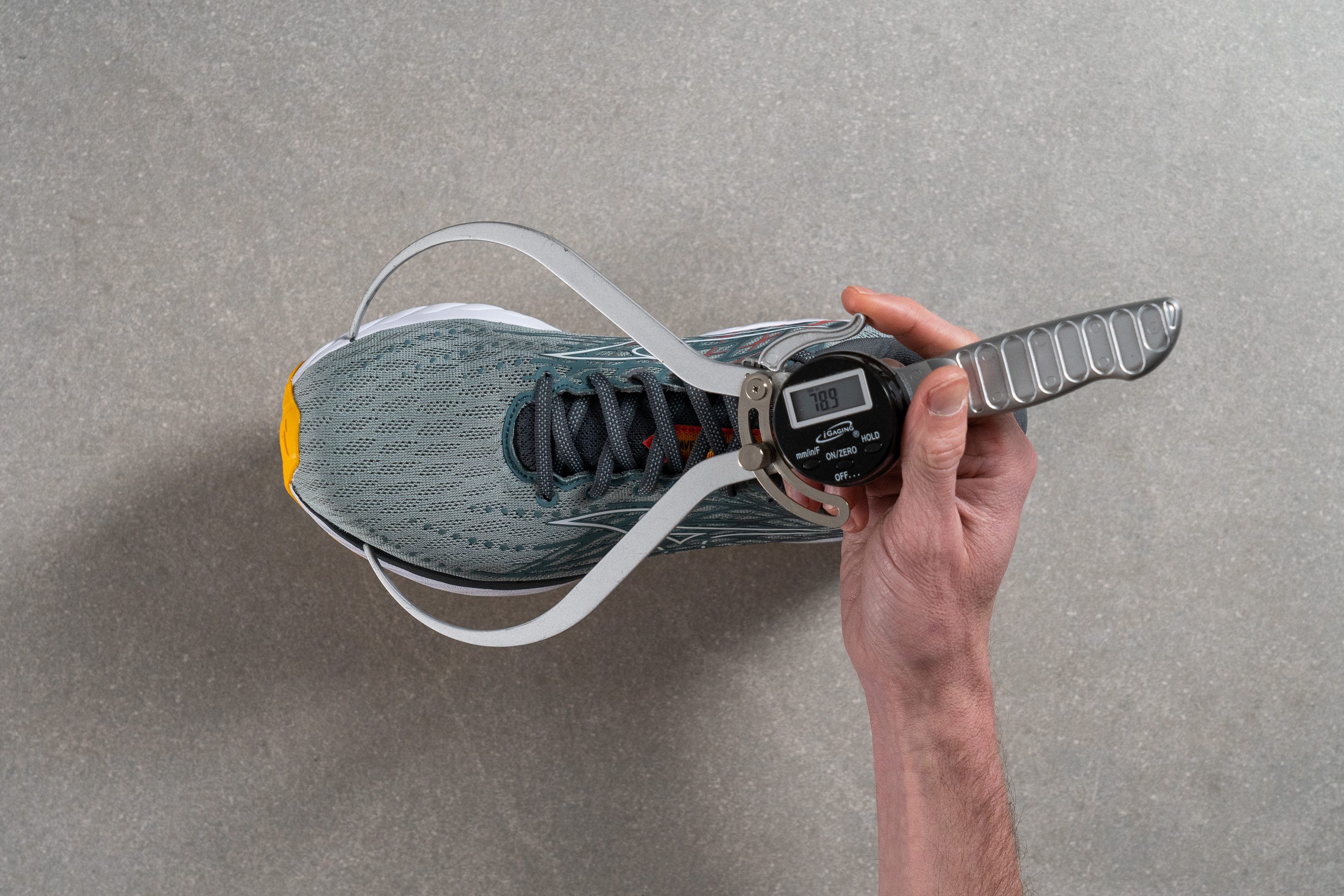
This test follows an older methodology, which is why you don't see recently tested shoes in the chart. Results from different methodologies can not be compared.
| Wave Inspire 20 | 78.9 mm |
| Average | 78.4 mm |
Traction / Grip
Traction test
Despite the generous rubber coverage on the Wave Inspire 20, we found its grip underwhelming. With a score of 0.36, it lands below the average and performs noticeably better on dry pavement than on slick, rain-soaked surfaces.
| Wave Inspire 20 | 0.36 |
| Average | 0.48 |
Outsole design
The Wave Inspire 20's X10 outsole features a wavy tread pattern that stays true to the shoe's name and covers the major points of contact with the grounds.
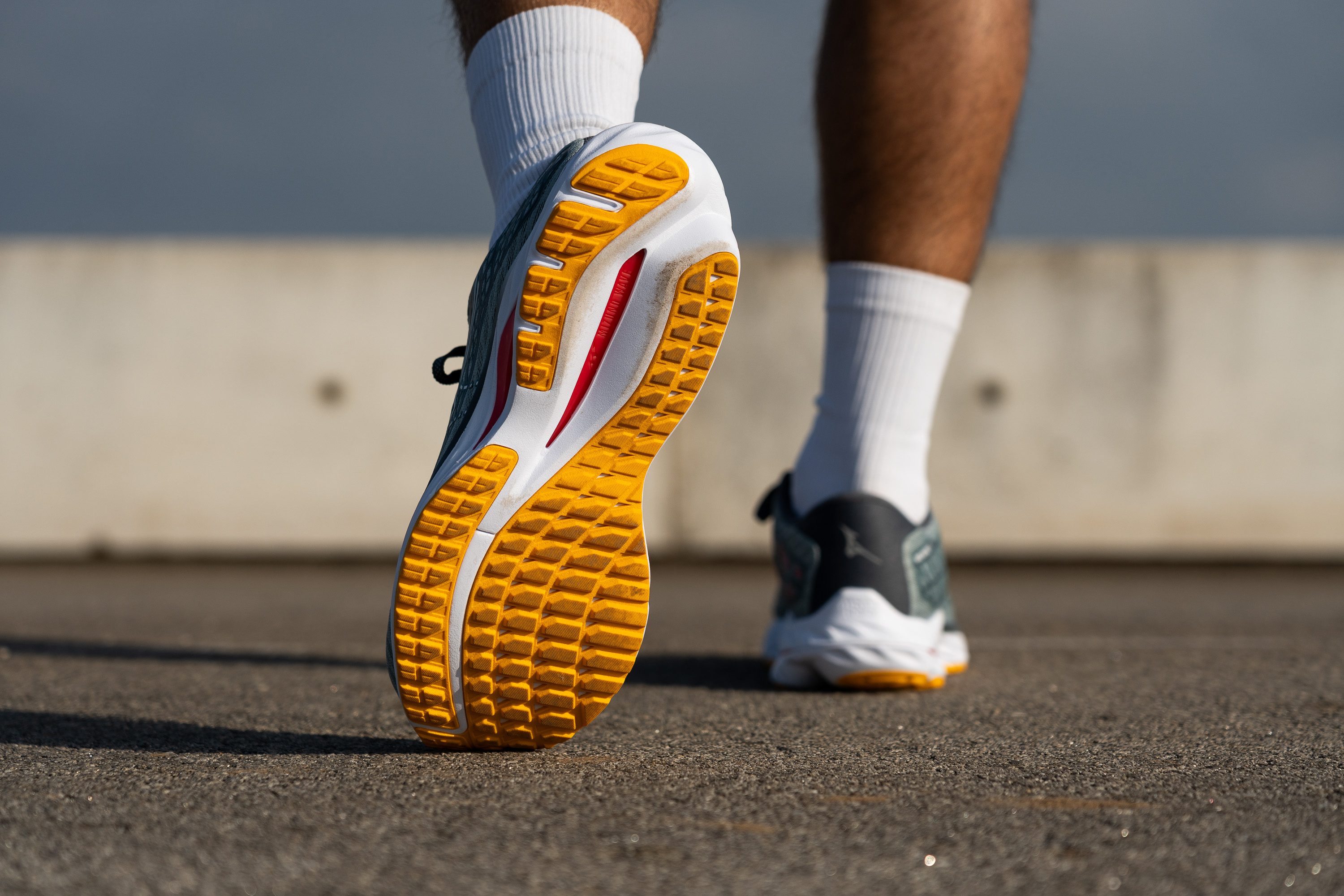
Flexibility / Stiffness
While it has a relatively high level of torsional rigidity, we found that only 13.8N of force is needed to torque the shoe to 30 degrees in our stiffness test. That's around the average and makes it a good option for daily use.
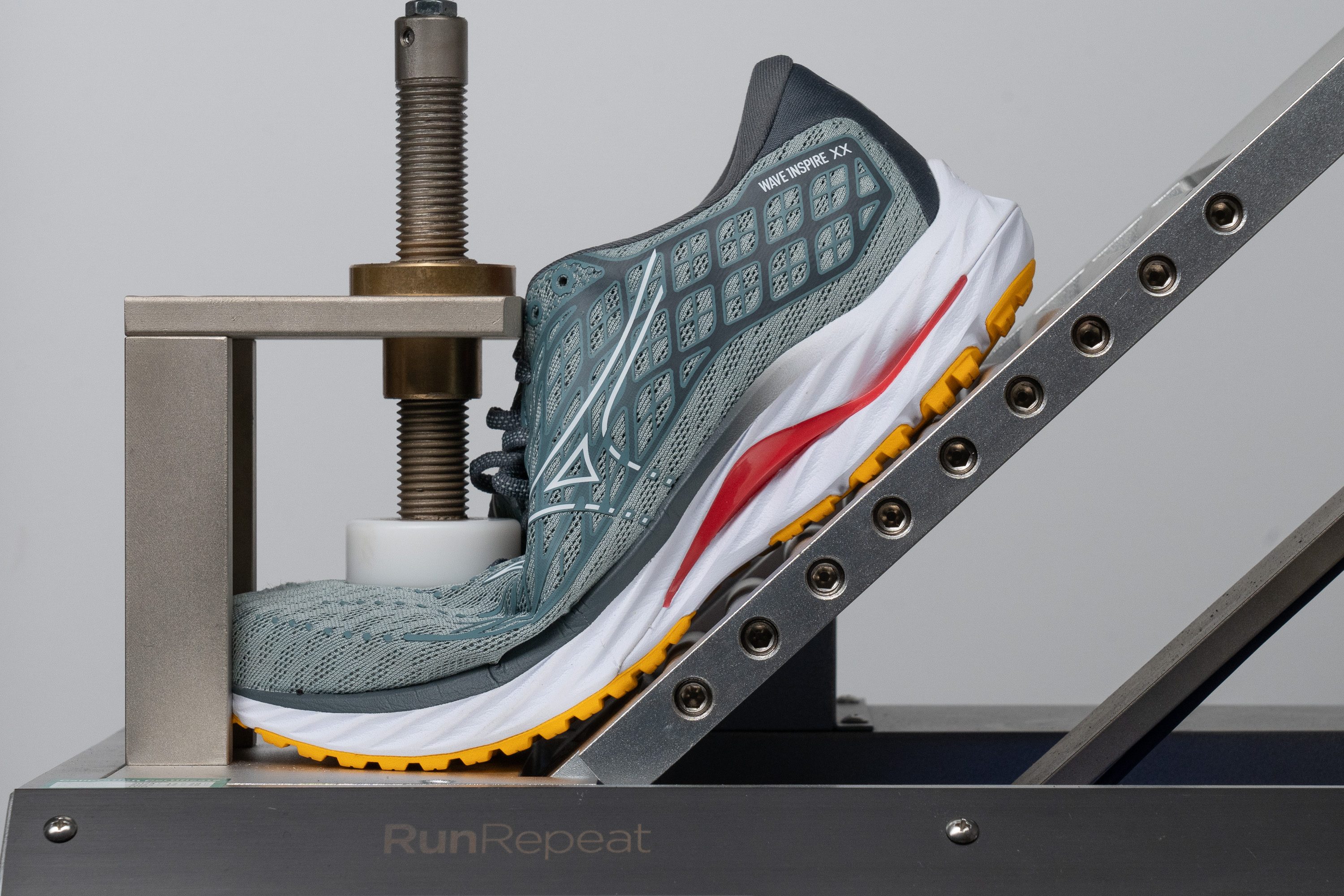
| Wave Inspire 20 | 13.8N |
| Average | 15.3N |
Stiffness in cold (%)
Becoming only 8.1% stiffer, the Wave Inspire 20 displays an impressively consistent performance as we repeat the flex test after leaving the shoe in our freezer for twenty minutes. As such, despite being well-suited for warm weather, the shoe will feel just as flexible and forgiving on the foot as temperatures drop.
| Wave Inspire 20 | 8% |
| Average | 33% |
Weight
Tipping our scale at 10.7 oz (302g), the Wave Inspire 20 is on par with the average stability shoe which tends to be on the heavier side when compared to most road shoes. That said, thanks to the rockered and responsive midsole, the Wave Inspire 20 never felt overly burdensome during our test runs, even when we pushing the mile markers.
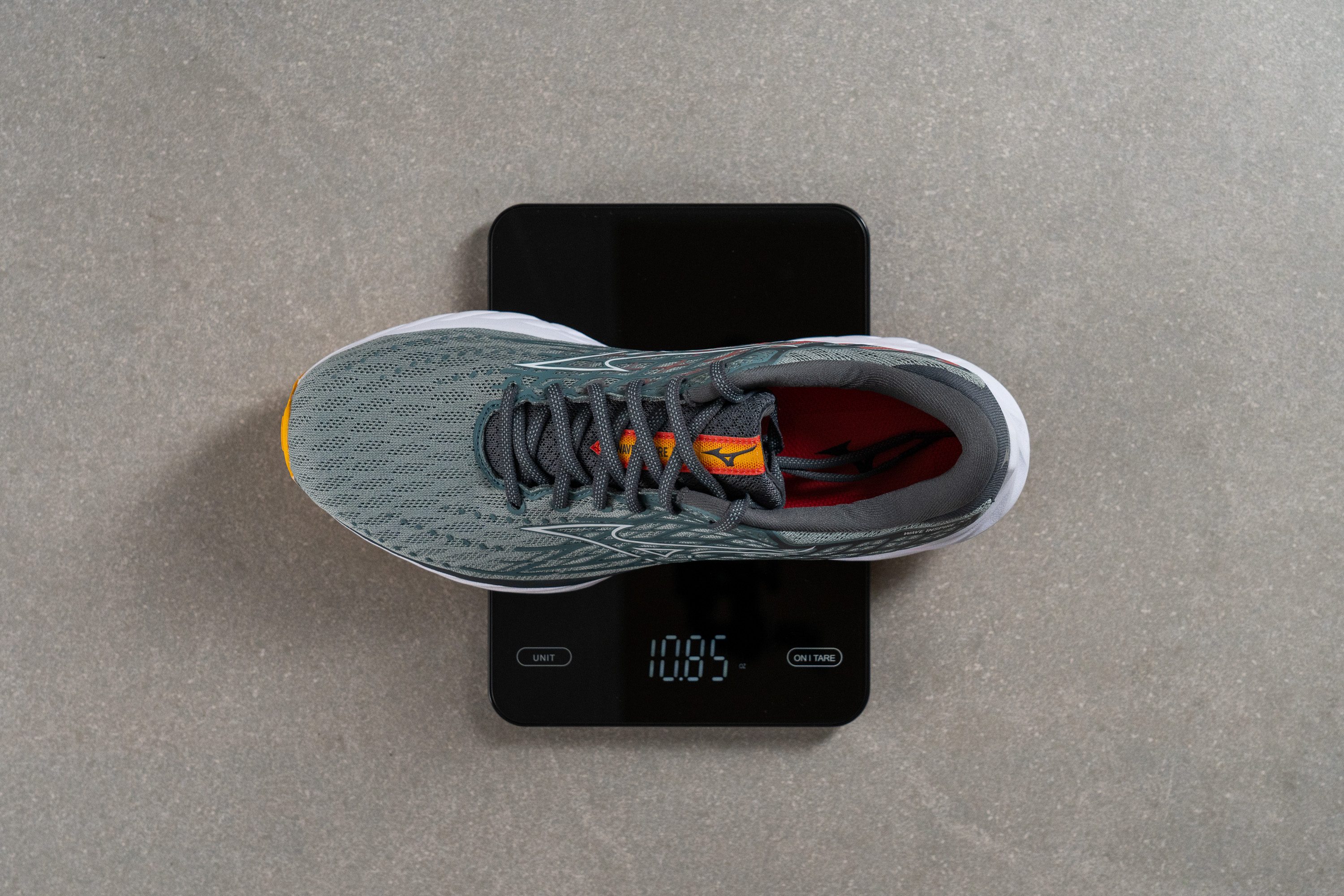
For runners looking for a more lightweight stability shoe that can also gobble up miles, we recommend checking out the Hoka Arahi 6.
| Wave Inspire 20 | 10.7 oz (302g) |
| Average | 9.3 oz (264g) |
Breathability
Despite a slow start in our breathability test, the shoe is suddenly engulfed in a haze of smoke that steadily filters through the entire upper. This leads us to give the Wave Inspire 20 a respectable 4 out of 5 in this assessment which indicates a good amount of airflow that allows heat to escape the shoe quite easily.
As we can see from inspecting a backlit cross-section of the upper, the light is able to shine brightly through the mesh at the toebox while the more reinforced lateral section blocks it out almost entirely. This more insulated portion is what prevents the shoe from achieving a perfect breathability score.
Looking at the toebox under our microscope, we see that the mesh is made up of a multi-layered network of braids with lots of little gaps for airflow that open up to form larger gaps that go all the way through the toebox. This explains the shoe's breezy nature which makes it a good warm-weather companion.


| Wave Inspire 20 | 4 |
| Average | 3.7 |
Stability
Lateral stability test
Despite the Wave Inspire 20's chunky stack, the shoe feels incredibly stable during our test runs. Rather than using rigid medial posts to achieve this, Mizuno opts for its signature Wave Plate embedded in the midsole (and visible through the cutouts) that lends the shoe its moniker.
The Wave Inspire 20's heel is beveled in a way that allows us to land on the outside of our foot and smoothly transition to the forefoot. The Wave plate embedded in the midsole also helps evenly disperse the force of impact in tandem with the cushy Enerzy foam.
Additionally, its positioning under the arch of our foot feels incredibly supportive and makes the Wave Inspire 20 a good choice for those with flat feet.
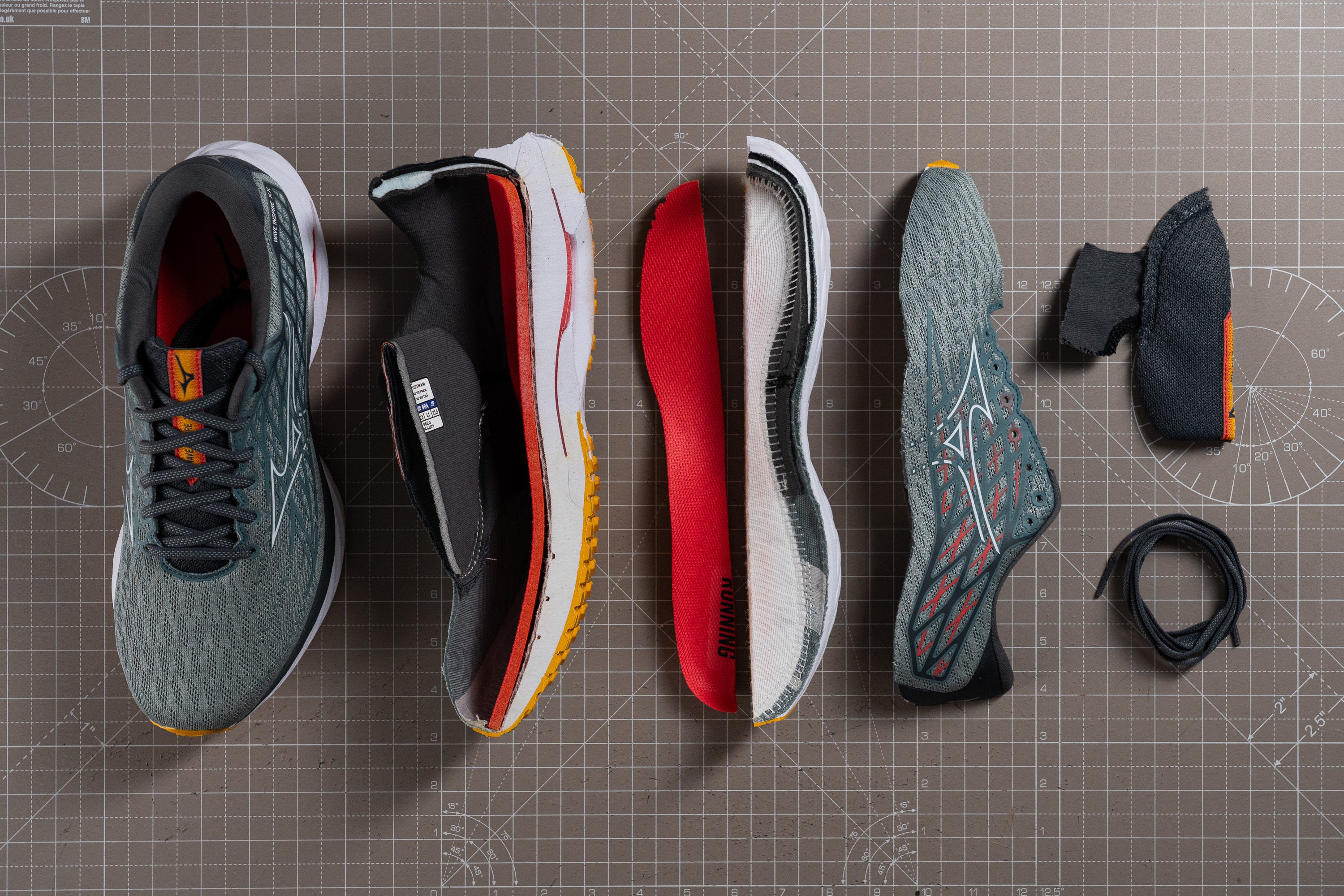
Further adding to its confidence-inspiring ride is how the midsole flares upwards to form sidewalls at the shoe's rear and medial side. This means that our feet feel cradled within the foam rather than perched precariously atop the Wave Inspire 20's high stack.

Torsional rigidity
The aforementioned Wave plate lends the shoe a relatively high level of torsional rigidity, leading us to give the Wave Inspire 20 a rather stiff score of 4 out of 5 in this manual assessment. As such, the shoe resists the excessive lateral movements of our foot during our test runs. This not only helps us maintain a more neutral gait but leaves us with a nice and steady landing platform for a surefooted and stable ride.
| Wave Inspire 20 | 4 |
| Average | 3.5 |
Heel counter stiffness
The Wave Inspire 20's heel counter also feels quite stiff as we squeeze and probe at it, leading us to give it a subjective score of 4 out of 5. This limits the lateral mobility of our rearfoot and helps us achieve a secure lockdown without putting too much pressure on our tendons.
| Wave Inspire 20 | 4 |
| Average | 2.9 |
Midsole width - forefoot
At 115.5 mm wide according to our caliper measurements, the Wave Inspire 20's midsole is slightly wider than average at the forefoot.
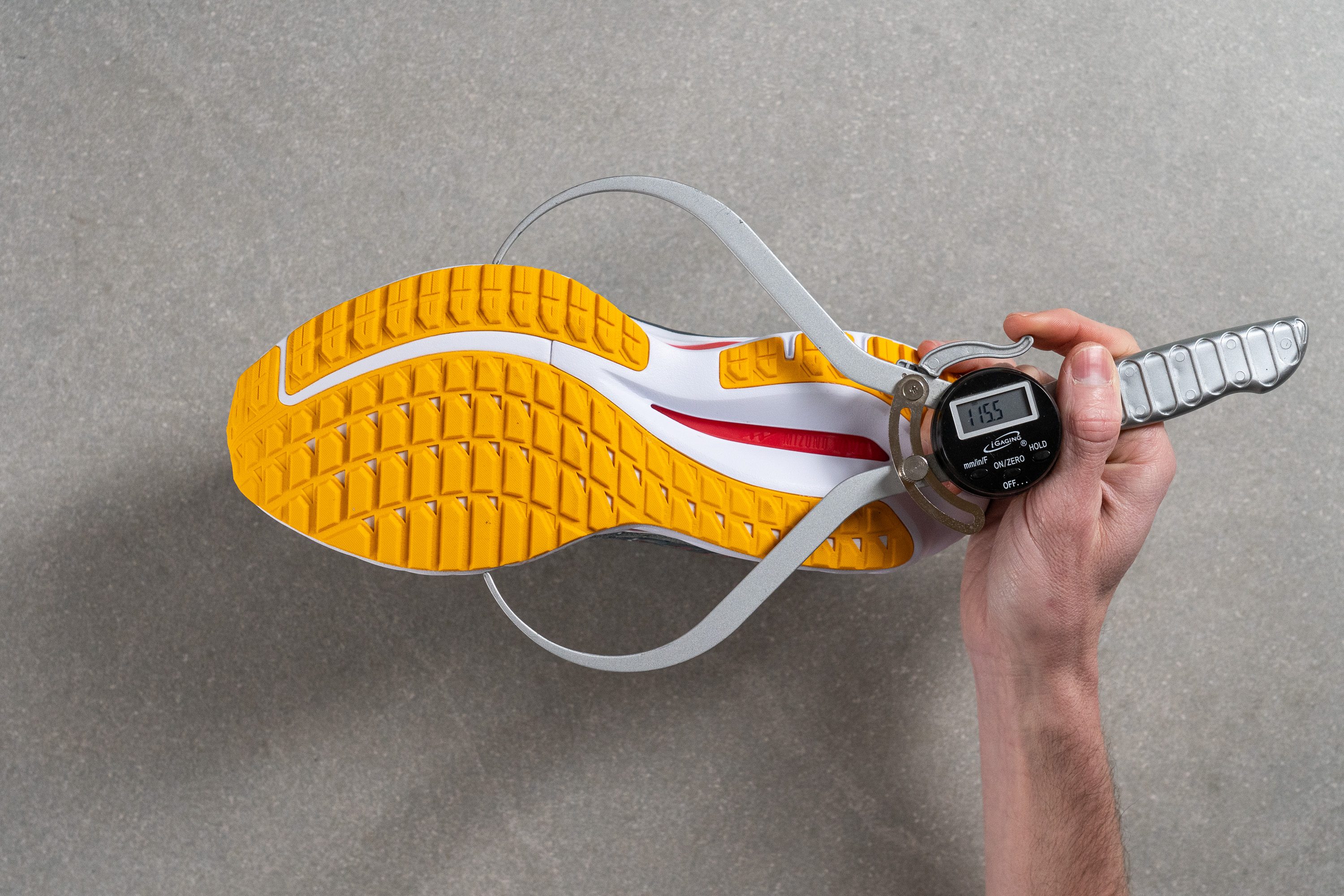
This gives us more than enough of a base to ensure stable landings and toe-offs without the shoe feeling too blocky when taking corners.
| Wave Inspire 20 | 115.5 mm |
| Average | 114.4 mm |
Midsole width - heel
The midsole is significantly wider than average at the heel, measuring 94.2 mm wide at the forefoot. This further confirms how well-suited the Wave Inspire 20 is for heel-striking runners as it gives them a very broad landing platform that's conducive to their stride.
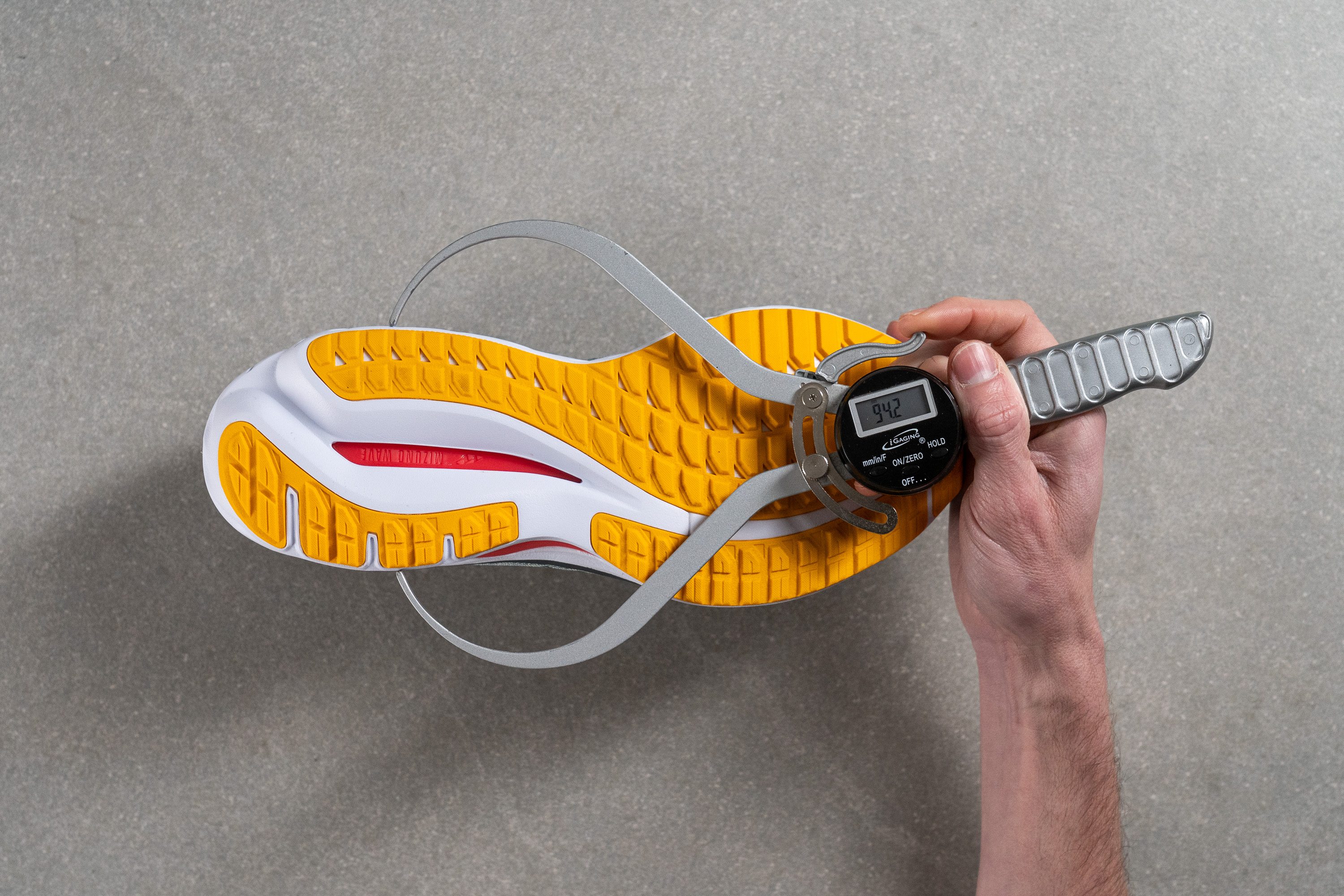
| Wave Inspire 20 | 94.2 mm |
| Average | 90.7 mm |
Durability
Toebox durability
Shoes with breathable mesh uppers don't usually do too well in our durability test but we were very impressed with how well the Wave Inspire 20 stood up to our imposing Dremel.
After withstanding four seconds of abrasive force simulating extreme wear and tear, we found that the toebox was left with only a small rip in the upper outer of its mesh. This earns the Wave Inspire 20 a toebox durability score of 4 out of 5 which is excellent for a road shoe. We, therefore, have added confidence taking this shoe off-road as an accidental bump on a rock of snag on a bush isn't likely to compromise the toebox.

Compare that to the ASICS Gel Pulse 13's which was left with a massive crater clean through the toebox that we could poke out toes out of.
| Wave Inspire 20 | 4 |
| Average | 2.6 |
Heel padding durability
The heel collar proved to be even more resilient in the face of our Dremel which wasn't able to bite into the lining material, with its abrasive element skating off it rather impotently during the four-second test.
Apart from a minor scuff, the Wave Inspire 20 escapes essentially unscathed with the padding within fully intact. This leads us to give it a perfect 5 out of 5 in this assessment and means that we don't expect any issues with rearfoot comfort or lockdown throughout the shoe's lifetime.
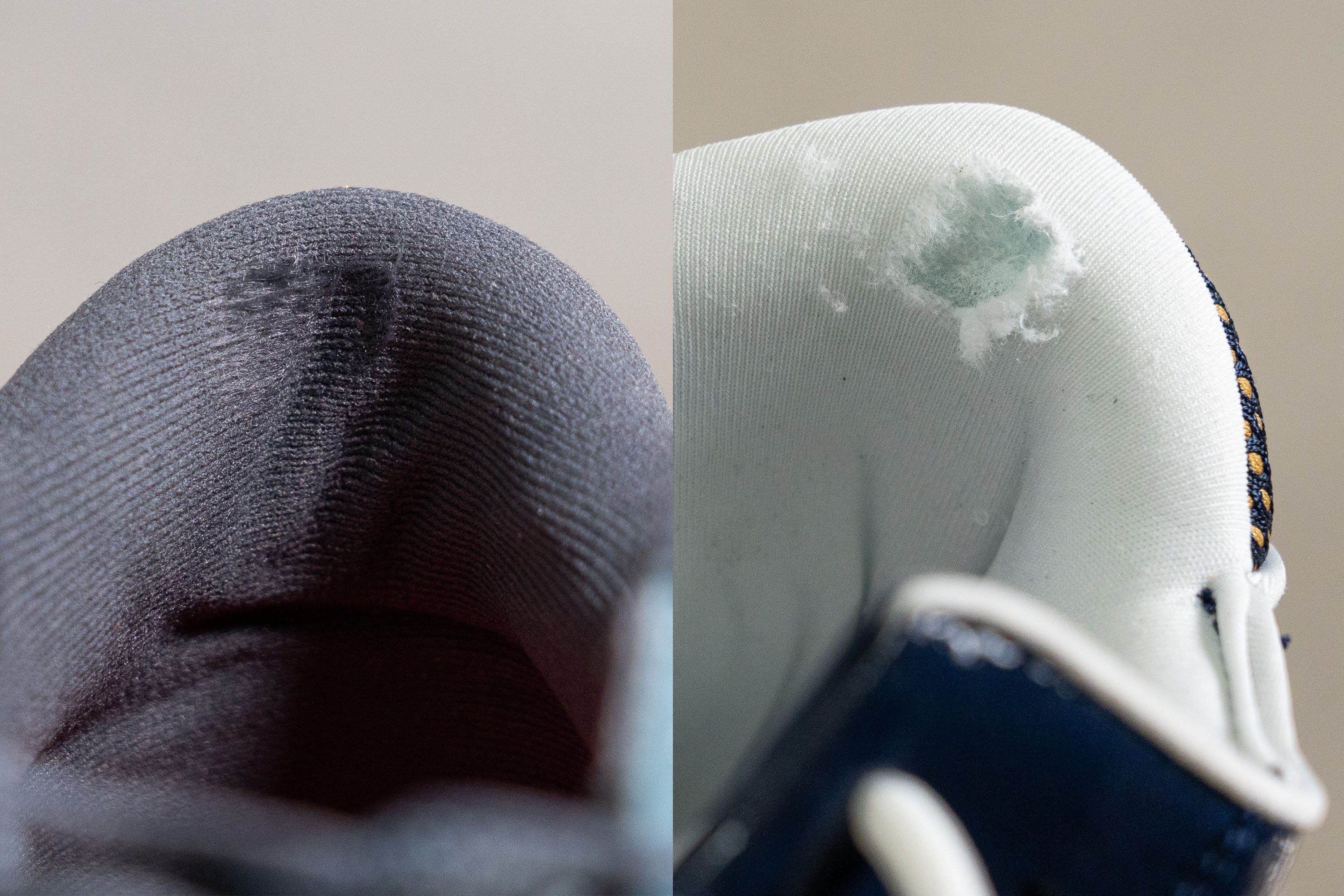
The Reebok Answer DMX, on the other hand, had its heel collar obliterated and much of the padding yanked out by our tool.
| Wave Inspire 20 | 5 |
| Average | 3.4 |
Outsole hardness
The Wave Inspire 20's outsole is comprised of the brand's proprietary X10 carbon rubber that's marketed as providing excellent traction as well as high wear resistance. Giving us a slightly harder-than-average durometer reading of 84 HC bodes well for the outsole in the shoe's final face-off with our Dremel
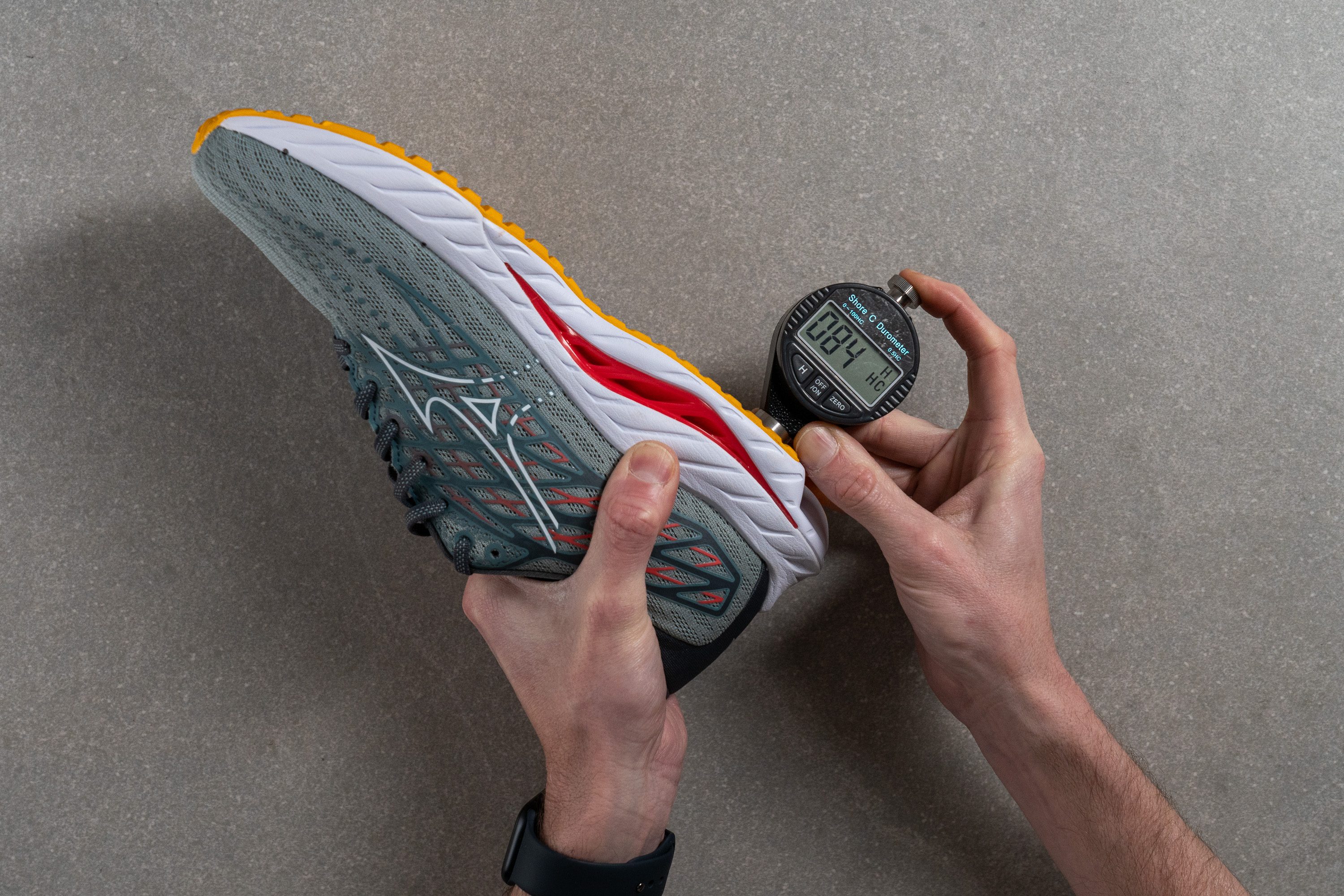
| Wave Inspire 20 | 84.0 HC |
| Average | 79.2 HC |
Outsole durability
With high expectations for the X10 rubber, we fired up our Dremel to 10K RPM and set it against the outsole with 3.2N of force. After twenty-two seconds of grinding, we used a tire tread gauge to measure the indentation and were somewhat surprised.
With 0.9 mm of material lost from the outsole, the X10 didn't deliver the performance we had anticipated. Instead, it's just average. This isn't necessarily a bad thing, though, as we still think that this shoe will last the predicted shelf life of 400 to 500 miles of use, even if used on mild trails occasionally.

| Wave Inspire 20 | 0.9 mm |
| Average | 1.1 mm |
Outsole thickness
The Wave Inspire 20's outsole falls in line with our current lab average at 3.2 mm thick according to our caliper measurements. This amount of rubber gives us a deep enough tread for solid traction as we tested the shoe on various surfaces without adding too much weight underfoot.
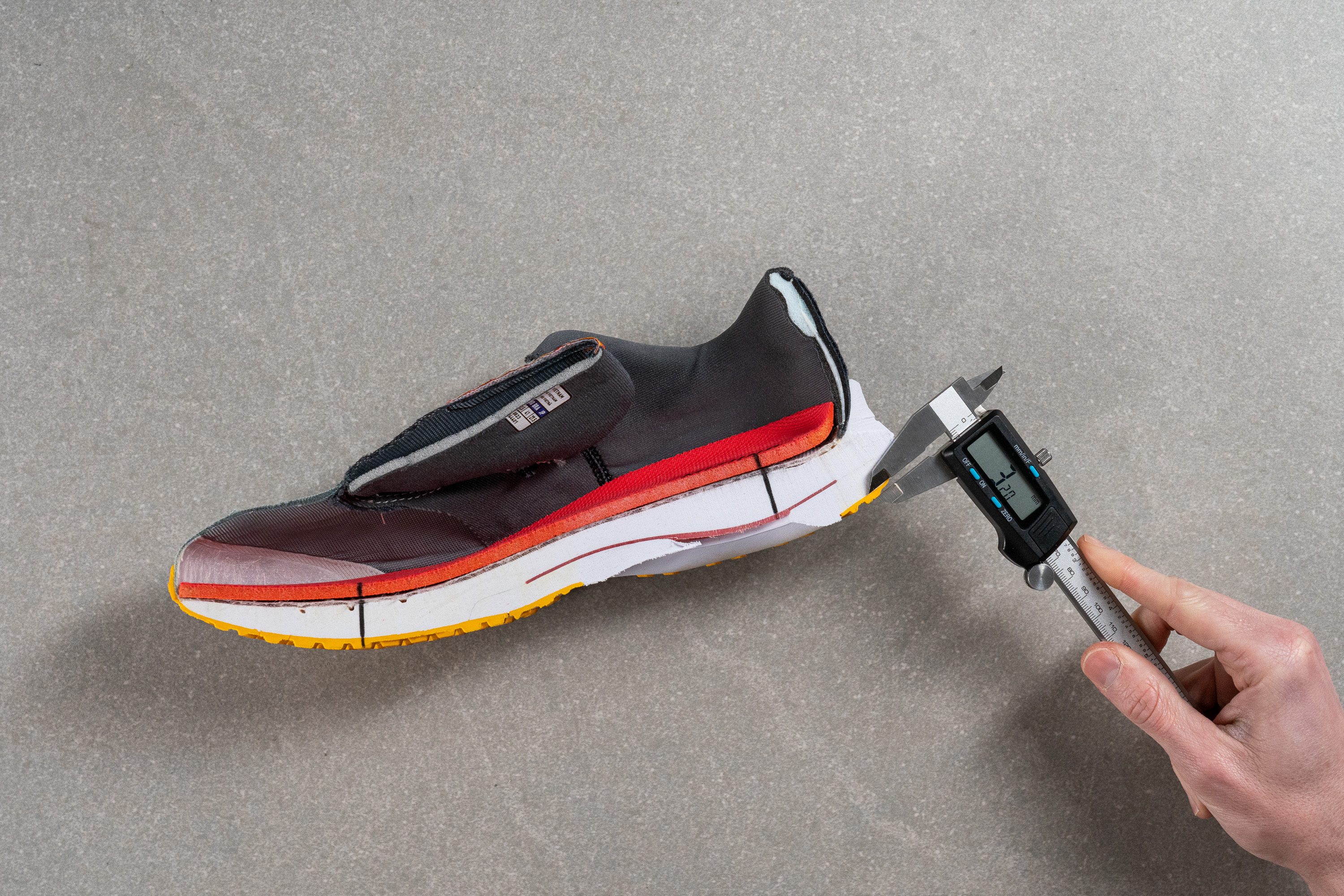
| Wave Inspire 20 | 3.2 mm |
| Average | 3.2 mm |
Misc
Insole thickness
At 5.5 mm thick according to our caliper measurements, the Wave Inspire 20's insole is a little thicker than our current lab average. This gives us a nice and cushy footbed to sink into as the midsole works its cushioning magic.

| Wave Inspire 20 | 5.5 mm |
| Average | 4.5 mm |
Removable insole
The Wave Inspire 20's insole isn't glued in so replacing it in favor of an aftermarket alternative or a custom orthotic is possible where necessary.
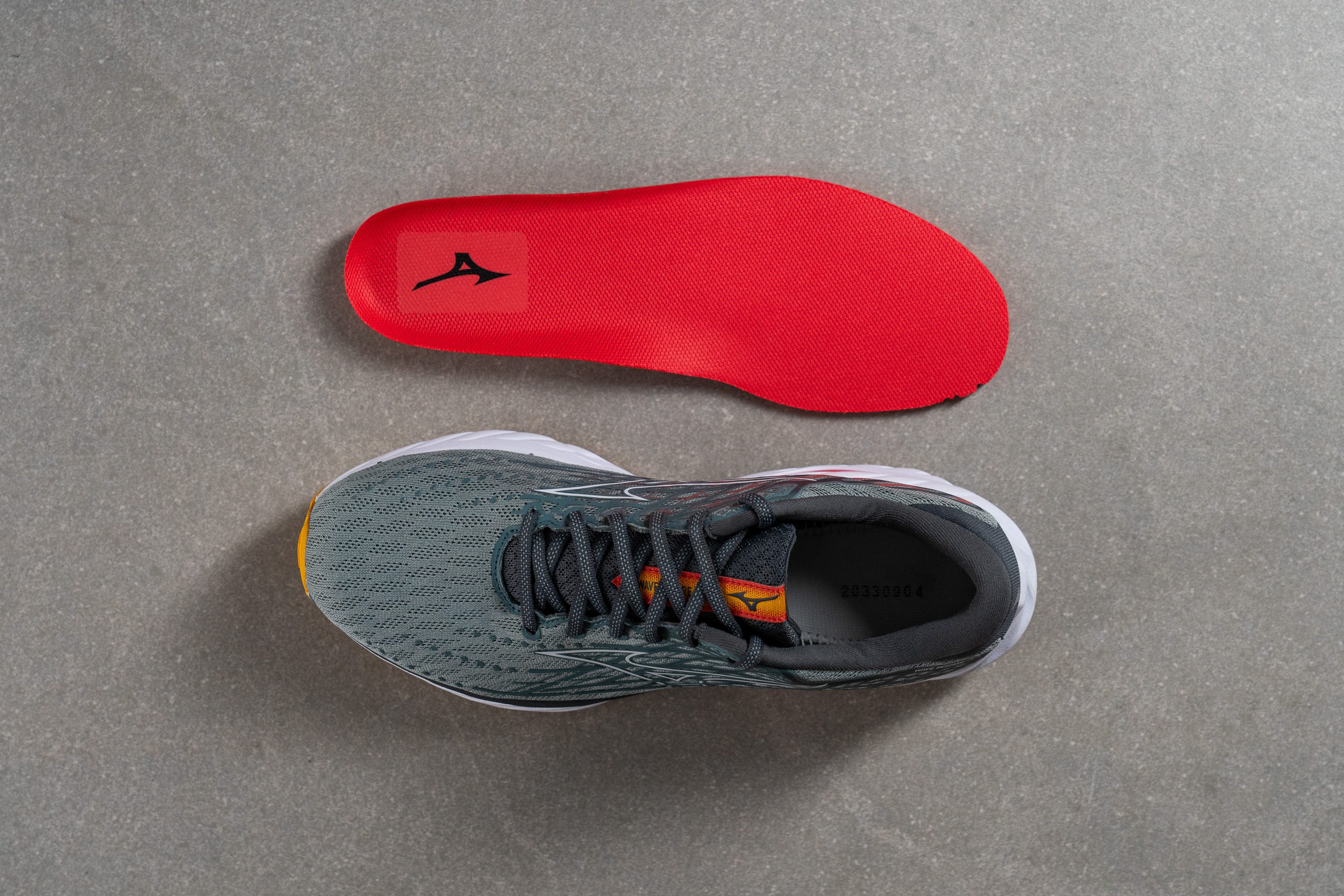
| Wave Inspire 20 | Yes |
Midsole softness in cold (%)
To test the effects of cold conditions on the midsole, we placed the Wave Inspire 20 in our freezer for twenty minutes. Once appropriately chilled, we pressed our durometer against the Enerzy Foam once more and were impressed to find that it only became 14.2% firmer. This makes the Wave Inspire 20 more consistent than the average road shoe under similar conditions and, with a reading of 25.1 HA, means that the shoe should still provide a balanced and comfy level of cushioning during the winter months. That said, with its relatively high breathability, we recommend pairing the Wave Inspire 20 with a pair of warm socks to avoid frosty feet on particularly frigid days.
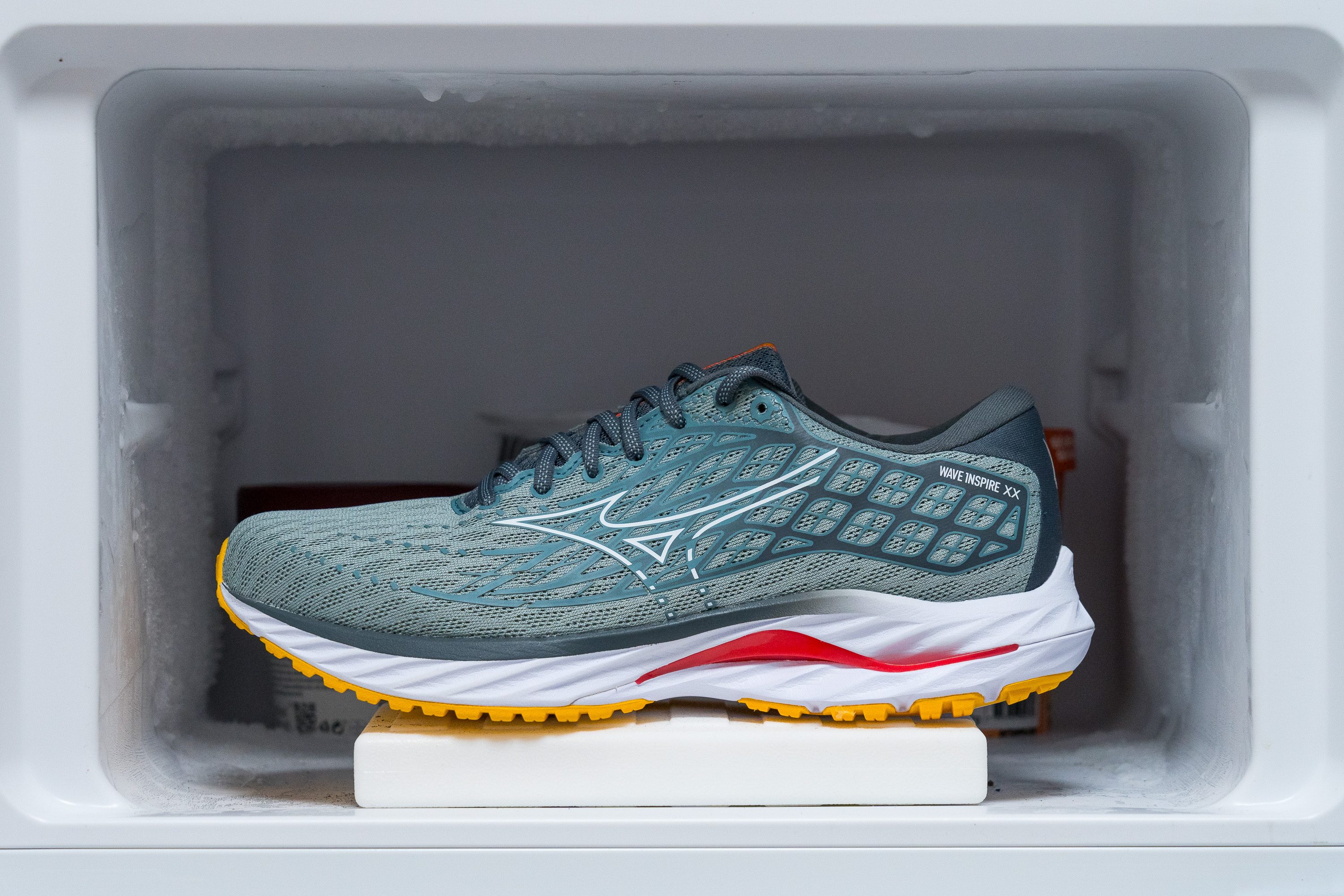
| Wave Inspire 20 | 14% |
| Average | 24% |
Reflective elements
With no reflective elements to be found on the shoe, we don't recommend using the Wave Inspire 20 on dimly lit routes at night without additional high-vis gear.
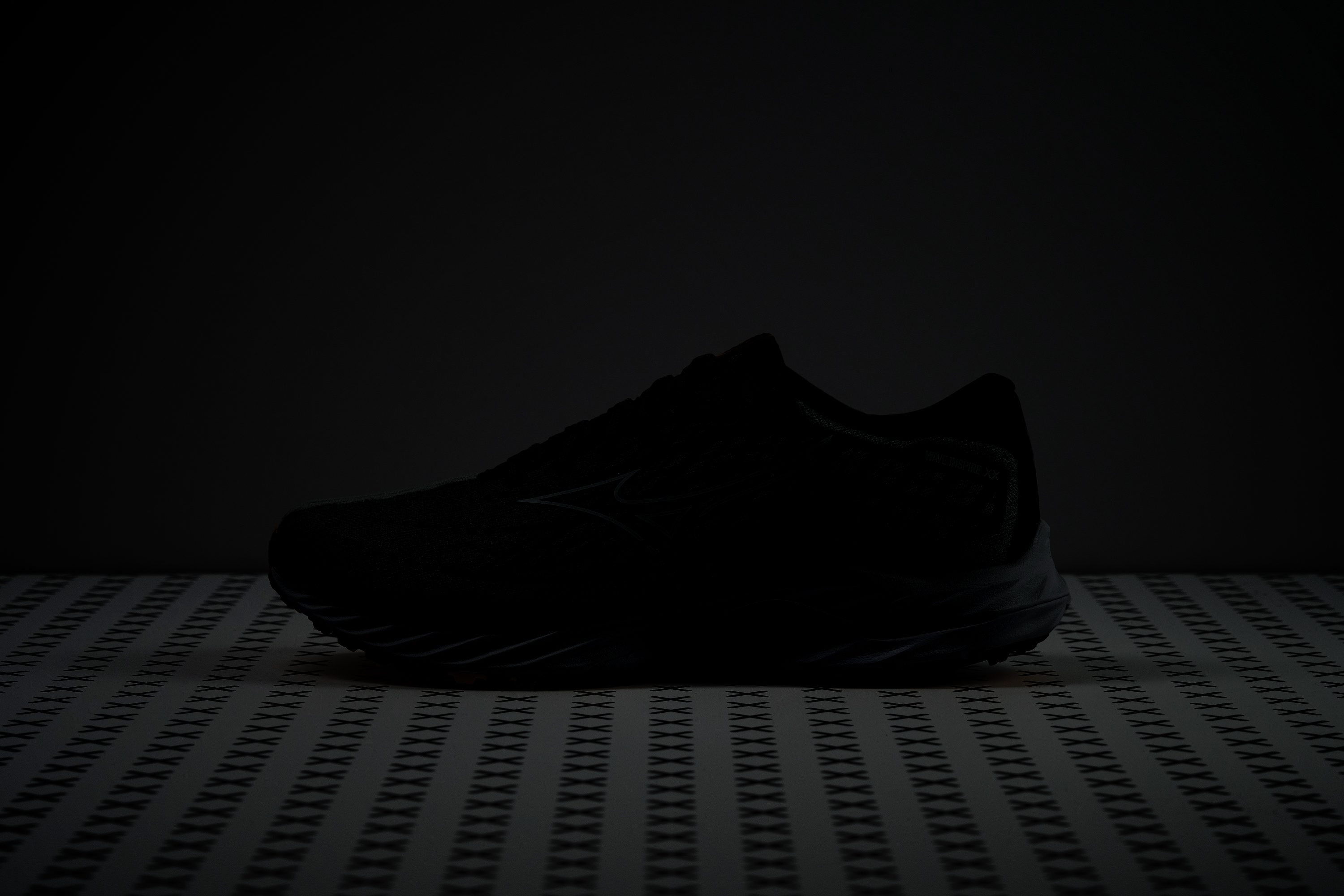
| Wave Inspire 20 | No |
Tongue padding
At 7.1 mm thick according to our caliper measurements, the Wave Inspire 20's generously padded tongue is thicker than our current lab average. As such, the shoe feels very comfortable across our instep and allows us to achieve a secure midfoot lockdown with no trace of lace bite during testing.

| Wave Inspire 20 | 7.1 mm |
| Average | 5.8 mm |
Tongue: gusset type
The Wave Inspire 20's tongue is semi-gusseted on both sides. We found this to be a welcome feature as it further contributes to our foot's locked-in feeling within the shoe while also preventing the tongue from slipping at higher paces.

| Wave Inspire 20 | Both sides (semi) |


















































